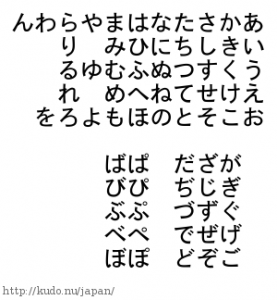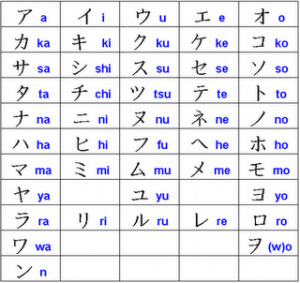 For the good part of 25 years, the thought of learning Japanese has flitted in and out of my mind. For most of that time, either inaccessibility of resources and/or time has kept me from putting any serious effort into it. In the last three years, I’ve made two abortive attempts, both ending after collecting resources, but never taking it anywhere.
For the good part of 25 years, the thought of learning Japanese has flitted in and out of my mind. For most of that time, either inaccessibility of resources and/or time has kept me from putting any serious effort into it. In the last three years, I’ve made two abortive attempts, both ending after collecting resources, but never taking it anywhere.
They say three’s a charm, so with this third attempt, I’m going to write about my experience, which I’m hoping will keep me on track. That’s the problem with self-study sometimes, motivation. I’ve set a goal of trying to reach an elementary level of reading that will allow me to read manga. Speaking is going to be secondary, but since it’s helpful to learning the letters, I will be working on it somewhat along side the reading and writing.
I’m starting with the basic, of course, and that means learning kana, the Japanese alphabet. It’s broken up into two sets, hiragana, which is for Japanese words, and katakana, which is used mostly for foreign-originated words or words that don’t exist in Japanese. There are 46 symbols in each and learning both is necessary.
 Like learning the ABCs in English, the best way to memorize hiragana and katakana is by rote and repetition. My memorization begain with a list of mnemonics I found on a website a few years ago. The site is gone now, but a google search of “hiragana mnemonics” and “katakana mnemonics” will bring up several pages with different mnemonics. If you are a visual learner, this will really work. It has for me. I worked on the hiragana two years ago, and when I picked it up again this month, the mnemonics I had learned came back to me easily and I could remember the first three sets of the vowels, the K’s, S’s, and most of the T’s. My method is to write the symbol and the mnemonic that goes with it. It really helps to imagine the image it gives, and then I write that symbol serveral times, repeating to myself the sound. Once I have a grouping done, I will then write the whole grouping, again repeating the sound of each symbol as I write.
Like learning the ABCs in English, the best way to memorize hiragana and katakana is by rote and repetition. My memorization begain with a list of mnemonics I found on a website a few years ago. The site is gone now, but a google search of “hiragana mnemonics” and “katakana mnemonics” will bring up several pages with different mnemonics. If you are a visual learner, this will really work. It has for me. I worked on the hiragana two years ago, and when I picked it up again this month, the mnemonics I had learned came back to me easily and I could remember the first three sets of the vowels, the K’s, S’s, and most of the T’s. My method is to write the symbol and the mnemonic that goes with it. It really helps to imagine the image it gives, and then I write that symbol serveral times, repeating to myself the sound. Once I have a grouping done, I will then write the whole grouping, again repeating the sound of each symbol as I write.
I have now memorized the entire hiragana and most of the katakana to the point that I can recognize them, though still with some thought. I only know a few actual words, and will start working on some vocabulary as I finish up the last of the katakana. It is rather rewarding when I can read some katakana and can sound out the English word it’s meant to be. This isn’t very easy, especially for words with “L”. But I’ve been able to incorporate my anime soundtracks with it. It really helps to read a song title and then listen for it in the music. “Sutaa Showa” in katakana becomes “Star Shower”, and “Kasumo Dorimu” is “Comic Dream”. It might seem silly, but I did get a bit of thrill when I figured those out. It’s the little successes I get with these that give me the encouragement to keep going.
Watch for next month and see if/how my vocabulary grows. Right now, I’m working on some basic works that use hiragana, as well as the parts of the face. These I got from the Japanese for Working People Kana Workbook, which you can find online here. It has some good exercises, but do try to memorize the the kana first. The workbook is good for reinforcement, not just learning. Here’s a cute picture I found of anime characters as katakana.
3 Comments
I wish you all the luck. I tried myself twice, but real life put those attempts on hold. I too found help with anime soundtracks. My Ghibli and Sailor Moon soundtracks were the best. I recently picked up Kanji de Manga by Manga University vols 1 – 4 at my local used bookstore. I am hoping to jump start my third attempt very soon. One interesting fact was the japanese proficiency test you can take here in America. There are 4 lvls and http://momo.jpf.go.jp/jlpt/e/about_e.html website gives more info. I hope to aim for lvl 1.
Sorry, my mistake….things are changing this year for the jlpt test. There will be 5 lvls…..Lvl 5 the easiest using kana, up to lvl 1 the most difficult. This site offers up to date info with sample tests with answers. http://www.jflalc.org/?act=tpt&id=8. I think I could get the writing down, but it’s the listening part of the test I would have trouble.
Being able to read katakana has helped me enjoy manga a lot more, ‘cos I can read the occasional untranslated sign and feel special, and can also figure out what the untranslated sound effects are in TOKYOPOP’s stuff. I’m pretty helpless in terms of Japanese vocabulary, and know practically zero kanji (seriously, I might know, like, 5), but even just being able to read English words written in katakana has its benefits.